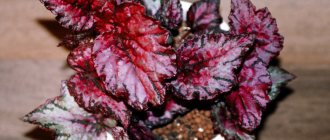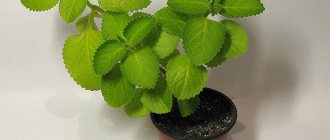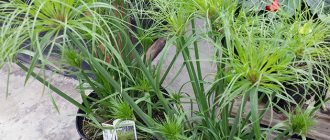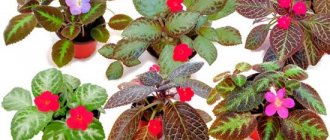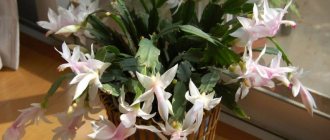- October 27, 2018
- Houseplants
- Svetlana Syabitova
This plant can decorate not only the garden; a large number of varieties have been bred to decorate residential and office spaces. Even novice flower growers can grow indoor lilies, photos and names of varieties of which can be found in the article. The plant is widely used in cosmetology and medicine. The bulbs of some species are quite edible, which is what small rodents, such as mice and squirrels, use.
Classification of indoor lilies
At home, lilies of a wide variety of colors, sizes and shapes are grown. Many varieties are specially bred for indoor floriculture. The most commonly used classification is based on the shape of the flower's petals. Below are photos and names of domestic lilies, or rather, the most popular varieties:
- the cup-shaped flowers are known as the Grand Commander, Gilded Lily, Belle Lily and Empress of China varieties;
- funnel-shaped petals - this species is represented by the largest number of varieties, for example, Royal Lily, Royal Gold;
- the flowers have bent petals, there are not very many varieties of this species, there are dwarf ones, Citronella.
Asian hybrids can be distinguished as a separate group; a distinctive feature of this group is the absence of odor. These are decorative species, with flowers of various colors, they can have stripes, spots, specks - beautiful house lilies, photos and names of which are also presented in the article. This species is highly resistant to diseases and is less susceptible to pests.
Curly hybrids with amazing flower shape. They need a little more moisture; they love leaf humus. For beginning flower growers, it is recommended to choose hybrid varieties; they are best adapted to home conditions.
Amazonian white indoor lily, photo and name, which is most often indicated in reviews of gardeners, has beautiful 15 cm flowers and a delicate aroma.
Sometimes lilies are confused with amaryllis. The main difference is the time of flowering: amaryllis blooms in winter, lilies bloom in summer and autumn.
Types of domestic lilies
To accurately distinguish amaryllis and hippeastrum, which often cause confusion, you should adhere to the following information. The first is represented by varieties, the second only by hybrids.
Agapanthus
| View | Description |
| Amaryllis | Sheds leaves during dormancy. Blooms in early autumn, in September. Funnel-shaped flowers ranging in color from white to red bloom on a dense stem. The bulb is round or conical in shape and covered with light-colored scales. |
| Hippeastrum | Usually covered with lanceolate leaves all year round. Only some hybrids shed them during the dormant period. It is capable of blooming twice a year, but more often it is used for forcing by a specific date. Flowers bloom on a hollow arrow stem. Presented in hybrids of various shades. The bulb is pear-shaped with gray scales. |
| Agapanthus, African lily | Blooms at the end of summer and blooms until the end of autumn. Agapanthus umbellata with blue inflorescences is usually grown. |
| Hymenocallis | Blooms in summer or winter. Throws out a long arrow with flowers resembling the elongated petals of spiders. |
| Eucharis, Amazon lily | The plant produces an inflorescence of white fragrant flowers on a high shoot. It pleases twice a year in late autumn and spring. In the center of the flower there is a large crown formed by overgrown stamens. A special feature of flowering is the large number of children and roots entangling the earthen ball. |
Planting indoor lilies
You can plant a plant yourself, but to do this you need to know how to do it correctly. First of all, you need to take care of the planting material. Bulbs are most often used, but seeds can be taken. First you need to get acquainted with the Indoor Lily flower, the photo and name of each variety, which, as a rule, are indicated in the annotation for the bulbs. The best time to purchase is autumn. It is important to pay attention to the quality of the bulbs; they should be smooth, dense, without scales or spots. Before planting, the material should be treated with a solution of potassium permanganate.
What matters is the size of the container in which the lily will grow. The pot should be deep, and the width should be calculated so that there is a distance of 3 cm from the bulb to the edge of the pot. Most often, containers with a diameter of 15 cm are used. If you choose a pot that is too large, the lily may not bloom at all.
Procedure for planting lily bulbs:
- Make drainage at the bottom of the pot: expanded clay and small stones will do.
- Sprinkle 5 cm of soil on top for bulbous plants; it should be light and nutritious.
- Place the onion in the center, carefully straightening its roots.
- Add soil and compact it slightly. As a result, the bulb should be placed in the ground to half its height.
- Moisten a little.
You can make the soil for indoor lilies yourself; for this you need to prepare the following composition: 3 parts of turf soil, 1 part each of river sand, humus, leaf soil.
The pot with the plant should be placed in a cool and well-lit place. After some time, the first shoots will appear, after which the lily is transferred to a permanent place.
You can plant several bulbs of the same variety in one container, but with different flower colors. As a result, during flowering you will get a very beautiful composition. You can see photos of domestic lily flowers that look spectacular in group plantings below.
Preparation of planting material and propagation
To propagate indoor lilies, one of two methods can be used:
- Seminal. A method when seeds purchased from intermediaries are planted in prepared soil and grown in compliance with the rules of care. The method is designed to ensure that the first flowers can appear only 5 years after planting. The disadvantage of the method is the inability to predict the result.
- Bulbous. This is the most common method. Planting bulbs and propagating the mother bulb in divisions allows you to obtain an adult plant with flowers in the second year after planting. The division of bulbs is associated with taking into account the characteristics of the root system.
When choosing planting material for cultivation, it is recommended to pay attention to the appearance of the bulb:
- You should not choose bulbs whose diameter is less than 3 cm;
- each bulb should be elastic, free from spots and growths;
- after forcing, the roots sent out by the bulb look weak, but this does not affect the growth of the lily after planting.
Planting material must be properly prepared for planting. If the purchased bulbs are too dry, they are placed in water for 2 hours, then removed for further storage. Before planting, the bulbs are stored in the refrigerator at a temperature of 0 to -2°C.
The bulbs are placed in a plastic bag filled with peat or sawdust. Drainage holes must be made in the bag. Before planting, the bulbs are disinfected in a manganese solution, and damaged scales are removed from the surface.
Plant care
For normal growth and abundant flowering, it is necessary to create favorable conditions for indoor lilies. When purchasing an indoor lily, a photo, name and care are included with the planting material. You should pay attention to them. Some varieties have slight distinctive features in their content. If everything is done correctly, the plant will not be affected by diseases and pests.
At the very beginning of growth, the flower needs a temperature of +10°C, after it has reached a height of 10 cm, it must be moved to a lighted place with a temperature of +16°C, but no more.
Later, for the growth of an adult plant, a temperature of +25 ° C and a lot of sun will be required. Lily is not afraid of direct sunlight, so it feels great on southern windows, and in the summer on balconies and loggias.
The indoor lily needs regular watering, but does not tolerate stagnation of water. It is necessary to water the plant as soon as the top layer of soil dries slightly. Water needs to be at room temperature. Experienced flower growers recommend watering the lily a little every morning and evening in the spring and summer.
If the room temperature is too high, spraying should be carried out. It must be remembered that lilies do not need too high humidity. To remove dust from the plant, you should wipe the leaf blades with a damp sponge once a week.
When buds appear, it is necessary to tie the plant to a support. The photo below shows how to do this correctly with house lilies.
How to plant a lily bulb in a pot
How to plant a lily bulb in a pot? Are there any differences from planting it in open ground? These are the questions that most often concern novice gardeners. Agricultural technology is similar in both cases. But to plant in a pot, you must follow a number of rules.
Planting a house lily bulb in a pot
Lavender in a pot - home care
In order for the bulbous indoor lily to take root, you need to prepare all the necessary material before planting:
- a pot, the height of which for tall plants should be at least 35 cm. To plant one bulb, you will need an area of 15 cm², so more than one bulb can be planted in one large pot;
- properly selected soil. The best option is to purchase a ready-made soil composition designed specifically for these flowers. For those who independently work on the composition of the soil, a mixture of turf and humus in equal parts is suitable;
- drainage;
- planting material, i.e. bulbs.
It is best to plant the bulbs in a pot in early autumn (early September), but you can also do this in the spring. Planting at this time will allow the flower to adapt to new conditions and sprout.
Note! In spring, you should also not delay this; plant it in a pot immediately when the first shoots appear. This could be the end of February, it all depends on the region and storage conditions.
How to grow lilies in a pot from bulbs
To properly grow these flowers at home, you need to start with choosing planting material and the correct planting technology. When selecting material, the following are taken into account:
- quality of material. There should be no rotten, moldy or infected bulbs;
- purity. Each bulb is cleared of the top layer of scales;
- only healthy roots. All flaccid ones are pruned;
- length of the root system. It should not be too long, in which case it must be cut;
- sterility. Each bulb must be treated with an insecticide before planting.
Planting lily bulbs in a pot
How to properly plant a bulb in the soil:
- Cover a third of the pot with pebbles for drainage, then with a layer of soil.
- For each bulb, make a hole twice as deep as the height of the bulb itself.
- Carefully place the planting material into the hole, being careful not to damage the roots.
- Cover with a layer of soil.
- Moisten it with a spray bottle, or with a growth accelerator.
- Mulch well.
How to grow lilies in a pot from seeds
Growing lilies from seeds is not difficult, but it is a little troublesome. Why this method is considered the safest is not difficult to guess, because the seeds definitely do not contain pathogens, rot, mold and other problems that a gardener faces in the process of other types of planting flowers.
Important! Planting can be done immediately after purchasing the seeds, but it is still recommended to carry out a 2-3-week stratification procedure.
It is recommended to sow seeds at the end of March. They will bloom only 2-3 years into the plant’s life. Sowing seeds occurs as standard, the same as for other flowering plants. Seeds are planted in the prepared light soil mixture. Can be planted at a distance of 1 cm. Be sure to put a drainage layer on the bottom of the container. Cover it with glass or film on top, sometimes open it for watering and ventilation. The temperature should be maintained at 20-25°C. The place should be dark. When the first true leaves appear, the flowers are transplanted into separate containers.
What do lily seeds look like?
Feeding
For the normal development and flowering of indoor lilies, additional nutrition is necessary; if there is a lack of it, buds may not form. It must be remembered that active growth requires nitrogen fertilizers, and for flowering potassium and phosphorus fertilizers should be applied.
The plant responds well to organic fertilizing, therefore, starting in spring, you can apply slurry, which is diluted with water in a ratio of 1 to 10. This fertilizer should be done once every three months.
It is best to feed the plant according to this scheme:
- the first feeding is done at the beginning of growth;
- the second during the formation of buds;
- the third is introduced after flowering.
In addition, you can add wood ash to the soil throughout the season. The indoor lily will decorate any room; photos of the best specimens can often be found in reviews of flower growers.
Signs and superstitions
Since ancient times, the flower has been considered a symbol of nobility and power. It was used to decorate castles, palaces, winter gardens, various celebrations and balls.
Now the flower is a symbol of warmth, harmony, strength of marriage, and serves as a talisman against the effects of negative energy. For example, a lily grown at home reliably protects the owner from witchcraft, bad thoughts and the evil eye.
Also, according to signs and superstitions, the flower brings financial well-being and helps avoid possible conflicts.
Obtaining indoor lilies from seeds
You can grow indoor lilies from seeds; the process is more labor-intensive and time-consuming. But the result will be a large number of plants that will be adapted to your conditions. First of all, you should take care of the planting material for indoor lilies, look at the photo and name in the article, and choose the most suitable option. After this, in order to get a healthy and beautiful plant, you should pay attention to the recommendations of gardeners.
Tips for growing lilies from seeds:
- their germination temperature is 20-25°C, different varieties may differ slightly;
- germination depends on the time of seed collection, the shelf life of planting material is no more than two years;
- no pre-treatment with cold is required;
- to speed up seed germination, you need to soak them for 15 hours;
- the best time for planting is February-March;
- soil composition: sand, peat, humus, garden soil;
- seed placement depth 0.5 cm;
- containers for planting should be selected with a height of about 10 cm;
- as soon as seedlings appear, the plants should be accustomed to normal conditions;
- diffused sunlight is required;
- do not allow the soil to dry out;
- When the first shoots appear, you need to reduce the temperature to 15-20°C.
As soon as the first true leaves appear, the plants should be transplanted into separate pots.
This process takes a lot of time and certain skills are required, so it is better for novice gardeners to purchase bulbous planting material.
How to make an Amazon lily shoot out an arrow: step-by-step instructions
If the Amazon lily is not happy with its flowering, you can help it a little. To do this, you need to create special conditions and force the plant to retire :
- Move the plant to a darker place.
- Reduce the temperature to 15 0C.
- Reduce watering the plant. Water only when the earthen ball dries out to two-thirds of the container.
- Be sure to stop any feeding.
After a month or two, the plant can be returned to its usual conditions. Usually, after taking these measures, eucharis blooms .
Eucharis is unpretentious in care and even a novice gardener can cope with its maintenance. By adhering to all the rules for caring for the plant, you can achieve effective flowering of eucharis every year.
What to do with a lily when it has bloomed
Beginning flower growers are often faced with the fact that the indoor lily has a flower (photo presented) with yellowed leaves and stem. How to help a plant in such a situation?
After lush flowering, a dormant period begins, at which time the entire above-ground part of the plant completely dies. Yellowed stems should not be cut off. During this period, you need to water once a week; the remaining nutrients in the leaves and stem will go into the bulb. As soon as the leaves and stem are completely dry, stop watering.
You can place the bulbs in a bag with wet sawdust and moss and put them in the refrigerator. It is better to place it in another place where the temperature will be +4-6°C.
What to do after flowering?
After flowering has ended, some leaves turn yellow and lose their decorative effect. Do not remove them from the pot. Nutrients from fading leaves enter the bulb and help the laying and development of children.
The wilting of flower stalks indicates the onset of the dormant phase. Watering is reduced and fertilizers are not used. Care after flowering is discussed in more detail on this page.
Why did the lily turn yellow?
Lily demands attention. The indoor lily has turned yellow, a photo of the flowers can be seen below. Novice gardeners are wondering what can be done, how to save the plant? It is necessary to understand why this happened.
Causes of yellowing of leaves and stems:
- Autumn has come;
- watered incorrectly;
- the surrounding air is too dry;
- insufficient nutrition.
If the lily turns yellow in the fall, then this is normal. If there are errors in care, it is necessary to humidify the air, water it in the morning and evening, and feed it with fertilizers that contain potassium and iron.
Why doesn't the lily bloom?
We purchased a homemade lily, the photo on the package promised the appearance of a beautiful flower, but there were no buds for a long time. Why is this happening and what should be done?
The lily does not bloom for the following reasons:
- lack of food;
- not enough moisture;
- little sun;
- The container in which the onion was placed is too large.
It is necessary to change the conditions of maintenance and the indoor lily will bloom. Home care and photos of a specific variety can be found in the reports of flower growers. Increase the amount of fertilizing, water well, ventilate more and move the plant to a sunny windowsill. If the container for the plant was chosen too large, then the lily uses it for propagation: it forms new bulbs.
Care during growth and flowering
When cared for at home, indoor lilies require certain conditions during the growing season and flowering. When the bulbs sprout, organic fertilizing is carried out. A week later, phosphorus-potassium fertilizers are applied. Additionally sprayed with growth stimulants 2 times a week. When the lilies grow to 10 cm in height, add soil to the container. Complex mineral-organic fertilizers continue to be applied weekly. In the warm season, young plants can be taken outside. To do this, lilies are hardened off, gradually increasing the duration of stay in the fresh air from half an hour to 10 hours. If the temperature stays below 10 °C at night, the flower buds will develop poorly.
General care rules:
- As they grow, lilies are tied up or supported, as their flowers are large and heavy.
- Water the plant frequently, avoiding excess moisture. You can check the ground with your hand.
- Lilies love to be sprayed. Water should not get on the buds, otherwise the flowering period will be shortened.
- The soil should be loosened, adding humus to it.
- It is necessary to weed the soil to remove weeds.
Different varieties of indoor lily flowers have their own characteristics of care:
- Asian hybrids are considered the most unassuming. These plants have a long stem. The petals can be plain or painted in two or three colors, and often have inclusions. They love sun and partial shade. When growing them, moderate soil moisture is required. They have fairly stable immunity. These flowers are scentless, so many people prefer to keep them at home. Includes five thousand varieties.
- Martagon lilies (curly) are tall plants with turban-like drooping flowers. They grow on almost any soil and are shade-tolerant. Frost-resistant. They have good immunity. In total, there are about 200 varieties of curly lilies.
- White hybrids include plants with white and cream flowers. They require a lot of attention and knowledge to care for. They smell nice. They do not tolerate cold well. Susceptible to diseases. This group consists of approximately 30 varieties.
- Long-flowered lilies have large, elongated flowers. They have a strong aroma. Not winter-hardy. Popular as indoor plants. Currently, low varieties have been bred, reaching 40 cm. They are susceptible to pests.
- Oriental hybrids can be purchased in bloom in stores. They have large flowers. They love warmth and sun, loose and light soil. The group includes 1300 varieties.
Helpful information
When growing indoor lilies, a variety of situations can arise, so you may need the following advice from experienced gardeners:
- if in the summer the plant is taken out onto the balcony, terrace or garden, care should be taken to ensure that during rain the drops do not fall on the “pet”;
- in a sick, weakened plant, all buds must be removed;
- in the first year of life, flower ovaries need to be pruned;
- During the formation of buds, watering should be increased slightly.
Diseases and measures to combat them
House lilies can be affected by a variety of diseases, both fungal and viral. Their appearance is associated with violations in the maintenance of green “pets”. In addition, you can purchase planting material that was stored incorrectly or was infected with certain fungal diseases.
The most common diseases of indoor lilies:
- Botrytis is popularly known as gray mold.
- Fusarium, most often called “soft rot”.
- Mosaic.
High humidity is a favorable condition for the development of fungal spores; the plant becomes sick with gray rot.
External signs of Botrytis disease:
- first, small yellow spots appear on the bottom of the leaf blade;
- the affected area increases;
- the color of the spots becomes gray, these areas appear fluffy;
- rot spreads to the stem and then to the bulb;
- the above-ground part of the plant turns brown and falls off.
Infected domestic lily flower (photo can be seen below). It is easier to prevent the disease using preventive measures, avoiding stagnation of water and high humidity. To prevent the spread of the disease, all affected parts of the plant must be cut off and disposed of. You can try to save the bulb. To do this, remove the plant from the pot, rinse with water, and soak for half an hour in a 0.5% Fundazol solution. Plant in new soil.
Fusarium, popularly known as soft rot, resembles Botrytis in its external signs of damage to the above-ground part of the plant. You can distinguish them by the condition of the bulb. Black, watery spots form on the scales. The bulbs quickly become moldy and soften. The plant should be removed from the pot, all diseased parts should be removed and disposed of. Remove the affected areas of the onion, then soak it for 50 minutes in a 0.3% Rogor solution. If the root system is severely damaged, the plant cannot be saved.
Most often, the house lily is affected by the mosaic viral disease. They can easily infect lilies from vegetable and flower crops. In addition, it can be spread by pests: mites, aphids.
Signs of the disease:
- on the leaves you can see spots, most often elongated, white or black and white in color;
- leaves and buds are deformed;
- white stains;
- the stem and leaves rot;
- the upper part of the plant dies.
It will not be possible to save a plant infected with mosaic; it must be disposed of so that the virus does not spread further. A photo of an indoor lily with mosaic disease is presented below.
To combat mosaic, preventive measures are important; before planting the bulbs, they must be soaked in Fitosporin. To prepare it, you need to dissolve 4 drops of the product in 200 ml of water.
Description
Lily, called Lílium in Latin, is a perennial plant and belongs to the Liliaceae family. The leaves of this bulbous plant can be of a wide variety of shapes - from elongated to oval. The diameter of the bulbs is on average from 2 to 7 or even 20 cm.
Lily flowers can have white, yellow, red, golden, purple, pink, lilac colors of different shades, are distinguished by scalloped or smooth edges of the petals and yellow or black anthers.
Fans of fantastic flower colors will appreciate varieties with crimson, red, yellow spots and stripes on the petals. The diameter of the flower can reach 16-18 cm. 4-5 flowers bloom on each peduncle.
Compact varietal Lilies, which produce a small number of children, are ideal for indoor conditions. There are hybrids that grow up to 1.5 m in height, and those that form in the form of a lush bush.
For planting in a pot, it is better to choose oriental, dwarf, long-flowered and Asian varieties, for example, the beautiful, golden lily or hybrids from the Mid Century series.
Pests of indoor lilies
Both garden and indoor lilies can be attacked by harmful insects. Pests damage plants and buds, draw out juices, and infect them with various diseases.
The most common pests of indoor lilies:
- aphid;
- spider mite;
- scale insect;
- mealybug.
Harmful insects can appear if the conditions for keeping the plant are not met; the lily can become infected with them from other indoor plants. Insecticides are used to control pests.
Lily is one of the most beautiful flowers that decorate parks and gardens. There are a large number of varieties bred specifically for growing at home. Lilies are valued for their beautiful flowers of different shapes, shades and sizes. Growing lilies is not difficult, you just need to create the necessary conditions for it.
Hyacinth
Although hyacinths have a completely different shape of inflorescences and small flowers are collected in large clusters, individually they really resemble lilies. The plant is famous for its richness of colorful varieties and delicate aroma.
Photo: sady-msk.ru
Flowers that look like bells: names and photos

